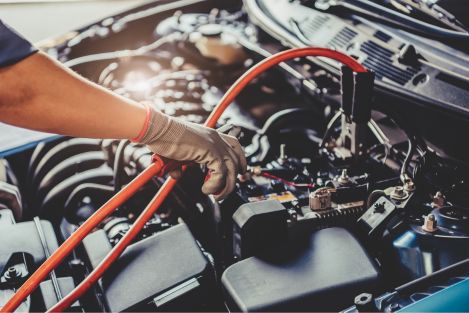
Written by Kayla Jane Barrie Updated on Nov 24, 2025 6 mins read

We have all experienced that dreadful moment when we turn the key, and instead of hearing the comforting hum of the engine, we are greeted with silence. A dead car battery can happen at the most inconvenient times, but there is no need to worry! With a bit of know-how and the right tools, you can jump-start your car battery and get back on the road in no time. This guide will walk you through the steps to jump-start your car safely and efficiently.
Boosting a car battery, also known as jump-starting, can be done by following these steps:
To determine whether your car's battery is dead, listen for a clicking noise or check whether the dashboard lights appear dim when you turn the key. If you turn the key and nothing happens, it could indicate a more serious problem like a faulty starter or alternator.
To start your car when its battery is dead, you will require a pair of jumper cables and a vehicle with a fully charged battery. Jumper cables can be easily purchased from auto parts stores and are an important tool that every car owner should keep in their car trunk or with their emergency car kit.
To jump-start a dead vehicle using jumper cables, you need to park the car with the charged battery as close as possible to the dead vehicle so that the jumper cables can reach both batteries. It is important to ensure that both cars are in park or neutral and that the ignition and all accessories are turned off before starting the process.
To connect the jumper cables, you should first locate both batteries' positive (+) and negative (-) terminals. Usually, the positive terminal is red and marked with a plus sign, while the negative terminal is black and marked with a minus sign. Check the manual to be sure.
To jumpstart a dead battery, follow these steps carefully:
Ensure the jumper cables are correctly connected between the two vehicles before attempting to jump-start the dead battery. Next, start the vehicle's engine with the charged battery and let it run for a few minutes. By doing so, the charged battery will transfer some of its power to the dead battery.
After a few minutes, try starting the vehicle's engine with the dead battery. If it starts successfully, keep both engines running for a few more minutes to ensure the dead battery gets a sufficient charge. This will help avoid any further issues and prevent the battery from dying again in the near future.
Once the dead vehicle is running smoothly, it's time to disconnect the jumper cables in the reverse order that you connected them:
It's a good idea to keep the engine running for at least 15-20 minutes to ensure that the battery gets fully recharged. This will give the alternator enough time to replenish the charge in the battery.
You might be in a rush to jumpstart your vehicle, but it's crucial to prioritize your safety and that of those involved. Here are some safety tips to keep in mind:
The lifespan of a car battery can vary significantly, depending on several factors. These factors include the type of battery, driving habits, weather conditions, and maintenance practices. A typical car battery can last anywhere from three to five years under normal conditions. Here are some factors that can affect the lifespan of your car battery:
It is crucial to monitor the health of your car battery regularly, as while the factors mentioned earlier can give you an idea of its expected lifespan, they are not definitive. If you observe any signs of a weak battery, such as slow cranking, dim headlights, or frequent jump-starts, it's advisable to have it tested by a professional.
Here are some common signs that indicate your car battery may be dead or dying:
If you experience any of these signs, having your battery tested as soon as possible is a good idea. Many auto parts stores and service centers offer free battery testing to help determine the condition of your battery. By addressing battery issues early, you can avoid being stranded with a dead battery and prevent potential damage to other electrical components in your vehicle.
Policies are designed to cover sudden and unexpected events such as accidents or theft. This means that auto insurance does not typically cover routine maintenance or wear and tear, including battery replacement. While it may be possible to get battery replacement covered in special circumstances, it is crucial to consider the low cost of the part when compared to the policy deductible before filing a claim.
If you are looking for coverage for battery repairs or replacements, consider roadside assistance programs. These programs can provide coverage for common roadside issues, including battery problems.
Car batteries in Canada operate at a standard voltage of 12 volts, which powers several components inside the vehicle. These batteries provide a consistent voltage output for reliable performance in diverse weather conditions nationwide. However, it's important to note that car batteries' capacity and cold-cranking amps may vary depending on the manufacturer and the vehicle's specific requirements.
Car battery prices in Canada vary based on brand, type, size, specifications, and retailer. On average, prices range from $100 to $300 or more. Brand reputation, battery type, and vehicle requirements can influence the price. Research options and consult experts to find the right battery for your needs and budget. Some retailers may offer installation services that affect the total cost.
Consider buying a portable booster pack for around $100-200 at your local retailer if you don't have jumper cables. Larger packs offer added features such as built-in radios, lighting, and tire inflators. Boosting your car with a booster pack is fast and safe, thanks to its built-in circuitry that prevents accidents. Avoid storing the booster pack in your vehicle during extreme temperatures.
Jumpstarting a car battery may seem intimidating, but it's a simple process that any car owner can learn with the right tools and knowledge. By following these easy steps, you can safely and efficiently jumpstart your car battery and confidently get back on the road.
Remember to drive for a while after jumpstarting your car to allow the battery to recharge fully. If you to boost it frequently, it may be time to have your battery or charging system inspected by a professional.
| Categories | Auto |
|---|---|
| Tags | Repairs and Maintenance |
Read our insurance blog to get helpful tips, information and news.
Has your car been totalled in an accident? Is your car a write off? Learn about vehicle write offs for a total loss insurance claim.
Get the facts on Toronto's auto theft problem. We break down the data, reveal the most-stolen vehicles (including the Honda CR-V and Lexus RX 350), and show which neighbourhoods are most affected.
Dive into the world of auto theft with our blog on the most stolen cars in Canada. See the most stolen cars across Canada, including provincial lists for Ontario and Quebec, and learn how high-risk models can affect your car insurance premiums.
Drive safe this winter! Check out these tips for driving in snowy and icy conditions in Ontario. Get other helpful info and FAQs on winter driving.